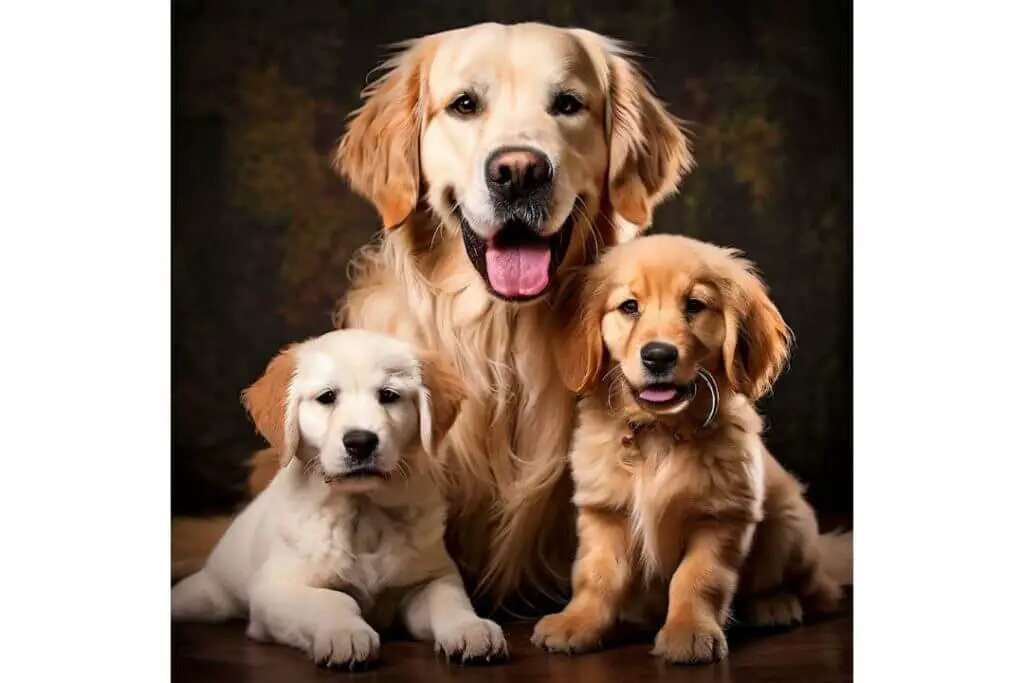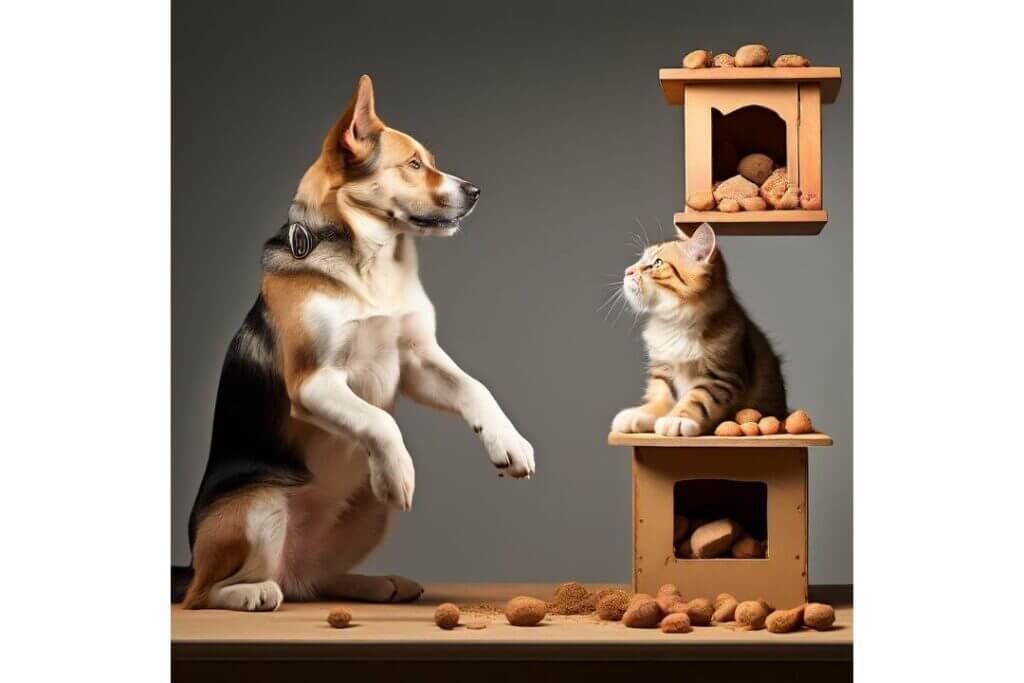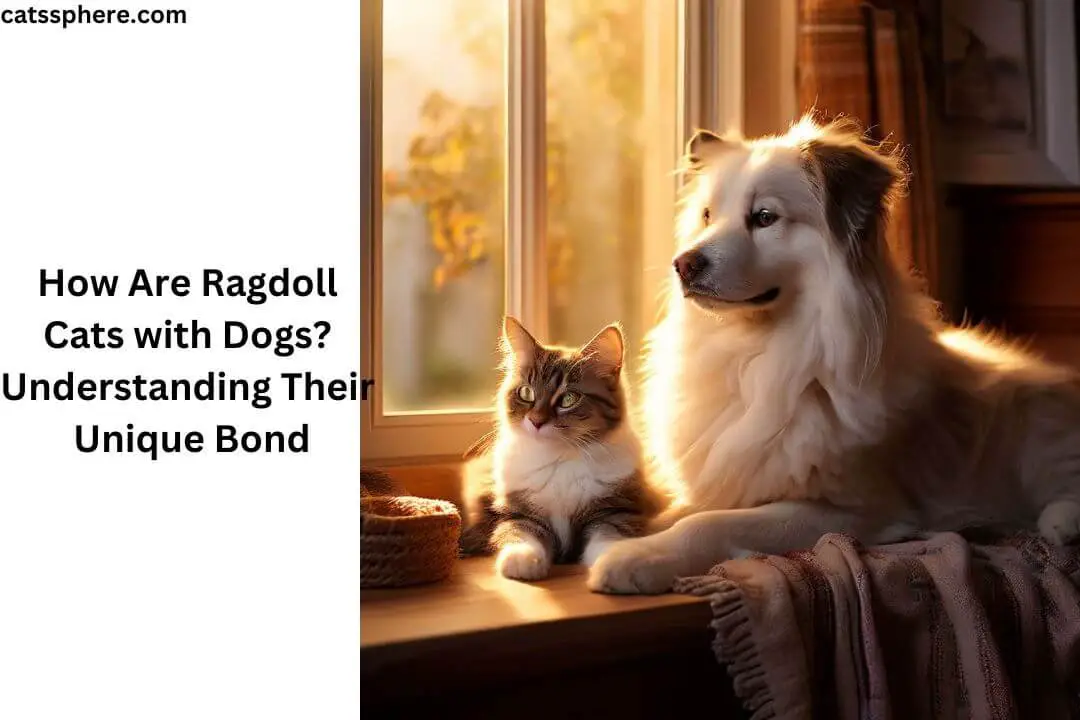Introduction:
Are you curious about How are Ragdoll cats with dogs? If you’re considering adding a Ragdoll cat to your household that already includes a dog, or vice versa, you’re likely wondering how these two pets will get along. The good news is that Ragdoll cats are known for their friendly and gentle nature, making them generally well-suited to living with dogs. In this blog post, we’ll explore five key insights into the unique relationship between Ragdoll cats and dogs, helping you understand what to expect and how to foster a harmonious environment for both pets.
Overview of Ragdoll Cats and Their Popularity
Ragdoll cats are a beloved breed known for their docile and affectionate nature. Originating in the 1960s, these cats have quickly gained popularity due to their striking blue eyes, semi-long fur, and relaxed demeanor. Understanding how Ragdoll cats interact with dogs is essential for pet owners considering a multi-pet household.
Introduction to Ragdoll Cats’ Temperament
Ragdoll cats are often described as “puppy-like” due to their playful and loyal behavior. They tend to be very social, enjoying human company and often following their owners around the house. This temperament makes them potentially good companions for dogs, provided the introduction is managed carefully.
Importance of Understanding Cat-Dog Interactions

Having both cats and dogs in one household can be a delightful experience, but it requires understanding the dynamics between these two different species. Properly managed introductions and ongoing relationship maintenance are key to a peaceful coexistence.
Brief History of Ragdoll Cats
The Ragdoll breed was developed by Ann Baker in California during the 1960s. She aimed to create a breed with a friendly and gentle personality, which she achieved by selectively breeding free-roaming cats with similar traits. The result was the Ragdoll, a cat that is as laid-back as it is beautiful.
Ragdoll Cats: Characteristics and Temperament
Physical Characteristics of Ragdoll Cats
Ragdoll cats are known for their large size, with males typically weighing between 15-20 pounds and females between 10-15 pounds. They have a muscular build, medium-length fur, and striking blue eyes. Their coats come in a variety of patterns and colors, including colorpoint, mitted, and bicolor.
Typical Temperament of Ragdoll Cats
Ragdolls are affectionate, calm, and sociable. They are often described as “floppy” because they tend to go limp when picked up, a trait that adds to their charm. Their gentle nature makes them excellent companions for children and other pets.
Unique Traits of Ragdoll Cats
One unique trait of Ragdoll cats is their tolerance for being handled and cuddled. Unlike many other cats, Ragdolls often enjoy being picked up and carried around. They are also known for their quiet voices and tendency to greet their owners at the door.
Ragdoll Cats’ Adaptability to Other Pets
Ragdolls are generally adaptable and can get along well with other pets, including dogs. Their calm and friendly demeanor makes them less likely to react aggressively to new animals, provided the introduction is handled correctly.
Dogs: Characteristics and Temperament
Overview of Common Dog Breeds

Dogs come in a wide variety of breeds, each with its own set of characteristics and temperaments. Some breeds are known for their friendly and easygoing nature, while others may be more territorial or energetic.
General Temperament of Dogs
The temperament of dogs can vary significantly depending on the breed, upbringing, and individual personality. However, many dogs are known for their loyalty, playfulness, and protective instincts. Understanding a dog’s temperament is crucial when introducing them to a new pet.
Dog Breeds Known for Getting Along with Cats
Certain dog breeds are known for their compatibility with cats. These include Golden Retrievers, Labrador Retrievers, Beagles, and Poodles. These breeds tend to be friendly, gentle, and less likely to exhibit aggressive behavior towards cats.
Ragdoll Cats and Dogs: Interaction Dynamics
How Ragdoll Cats Typically React to Dogs
Ragdoll cats are generally curious and calm when introduced to dogs. They may initially be cautious but are unlikely to show aggressive behavior. Their friendly nature often leads them to eventually accept and even bond with dogs.
Factors Influencing Cat-Dog Relationships
Several factors can influence the relationship between a Ragdoll cat and a dog, including the age and temperament of both animals, the environment, and the way the introduction is managed. Positive early interactions are crucial for a harmonious relationship.
Common Behaviors Seen in Cat-Dog Interactions
Common behaviors in cat-dog interactions include mutual sniffing, playfulness, and occasionally, dominance displays. Understanding these behaviors can help pet owners manage their pets’ interactions more effectively.
The Role of Socialization in Cat-Dog Interactions
Socialization is key to a successful cat-dog relationship. Exposing both pets to different experiences, environments, and other animals from a young age can help them develop a more tolerant and friendly attitude towards each other.
Introducing Ragdoll Cats to Dogs
Preparing Your Home for a New Pet
Before introducing a Ragdoll cat to a dog, it’s important to prepare your home. Create separate spaces for each pet initially, with their own food, water, and litter areas. This helps reduce territorial behavior and stress.
Steps to Introduce a Ragdoll Cat to a Dog
Start by allowing the cat and dog to smell each other through a closed door. Gradually introduce them in a controlled environment, using barriers like baby gates. Monitor their interactions closely and reward positive behavior with treats and praise.
Monitoring Initial Interactions
The first few interactions are crucial. Keep sessions short and positive, gradually increasing their time together. Watch for signs of stress or aggression, and separate them if necessary to prevent negative experiences.
Signs of Positive and Negative Interactions
Positive signs include relaxed body language, playful behavior, and mutual grooming. Negative signs to watch for include hissing, growling, raised fur, and aggressive posturing. Address negative behaviors promptly to prevent escalation.
Can Ragdoll Cats Go Outside? Is It Safe and Advisable
Ragdoll Cat vs. Himalayan: A Detailed Comparison
Living with Ragdoll Cats and Dogs
Creating a Harmonious Environment
A harmonious environment is essential for a peaceful multi-pet household. Ensure both pets have their own spaces and respect each other’s territories. Regularly engage them in activities to keep them mentally and physically stimulated.
Managing Feeding Times and Spaces
Feed pets in separate areas to prevent food aggression. Establish a routine for feeding times to create a sense of security and predictability for both pets.
Providing Safe Spaces for Both Pets
Both pets should have access to safe spaces where they can retreat if they feel overwhelmed. For cats, this could be high perches or secluded areas. For dogs, a crate or a designated quiet room can provide a similar refuge.
Daily Routines and Activities to Foster Harmony
Incorporate daily routines and activities that involve both pets. This can include joint playtime, walks (for the dog), and interactive toys that they can enjoy together. Consistent routines help both pets feel secure and reduce the likelihood of conflicts.
Challenges and Solutions
Common Challenges in Cat-Dog Households
Common challenges include territorial behavior, food aggression, and differences in play styles. These issues can lead to stress and conflict if not addressed promptly.
Solutions for Behavioral Issues

Behavioral issues can often be addressed through training and positive reinforcement. For example, if the dog exhibits food aggression, feeding them in separate areas and gradually desensitizing them to the presence of the cat during meal times can help. Similarly, if the cat displays territorial behavior, providing them with vertical spaces and plenty of enrichment can reduce their stress and aggression.
Training Tips for Both Pets
Training is essential for both pets to understand acceptable behavior and boundaries. Basic obedience training for the dog, such as “sit,” “stay,” and “leave it,” can help them respond appropriately to commands and distractions. For cats, training can involve teaching them to come when called or to use a scratching post instead of furniture.
Professional Help and When to Seek It
If behavioral issues persist despite your efforts, seeking professional help from a veterinarian or animal behaviorist is recommended. They can assess the situation and provide tailored advice and training plans to address specific issues. Early intervention is key to preventing conflicts from escalating.
Personal Stories and Case Studies
Success Stories of Ragdoll Cats and Dogs Living Together
Many pet owners have successful experiences of Ragdoll cats and dogs living harmoniously together. These stories often highlight the strong bond that forms between the two pets, with the Ragdoll cat often taking on a nurturing role towards the dog.
Real-Life Challenges and How They Were Overcome
Of course, not every cat-dog relationship is smooth sailing from the start. Real-life challenges may include initial conflicts, territorial disputes, or personality clashes. However, with patience, consistency, and proper management, these challenges can often be overcome.
Interviews with Pet Owners
Interviews with pet owners who have experience with Ragdoll cats and dogs can provide valuable insights and advice. Hearing firsthand accounts of their successes and challenges can help new pet owners feel more prepared for integrating their own pets.
Expert Insights on Cat-Dog Dynamics

Animal behaviorists and veterinarians can offer expert insights into cat-dog dynamics. They can provide guidance on understanding pet behavior, managing introductions, and resolving conflicts. Their expertise can be invaluable for pet owners navigating the complexities of multi-pet households.
Health and Safety Considerations
Health Concerns for Ragdoll Cats
Ragdoll cats are generally healthy pets, but they may be prone to certain health issues such as hypertrophic cardiomyopathy (a heart condition) and polycystic kidney disease. Regular veterinary check-ups and a balanced diet can help maintain their health and well-being.
Health Concerns for Dogs in a Multi-Pet Household
Dogs in multi-pet households may be at risk of stress-related health issues if conflicts arise with other pets. Additionally, they may be susceptible to common canine illnesses such as parasites, infections, and joint problems. Proper preventive care, including vaccinations and regular vet visits, is essential for their health.
Preventive Measures for a Healthy Coexistence
Preventive measures such as keeping pets up-to-date on vaccinations, providing parasite control, and maintaining a clean living environment can help prevent the spread of illnesses and ensure a healthy coexistence between Ragdoll cats and dogs.
Vaccination and Vet Visits
Regular vaccination and veterinary visits are crucial for both pets’ health. Vaccinations protect against common diseases, while regular check-ups allow vets to monitor their overall health and detect any issues early on. Following your vet’s recommendations for preventive care can help keep both pets happy and health.
Expert Opinions and Advice
Veterinarian Insights on Cat-Dog Relationships
Veterinarians can offer valuable insights into the health and behavior of Ragdoll cats and dogs. They can provide advice on preventive care, nutrition, and managing multi-pet households to ensure the well-being of both pets.
Animal Behaviorists’ Tips
Animal behaviorists specialize in understanding pet behavior and can provide guidance on managing cat-dog relationships. They can offer training techniques, behavior modification strategies, and advice on creating a harmonious environment for both pets.
Recommendations from Pet Trainers
Pet trainers can assist with obedience training and behavior modification for both Ragdoll cats and dogs. They can help pet owners establish routines, set boundaries, and reinforce positive behaviors to foster a peaceful coexistence.
Advice from Experienced Pet Owners
Experienced pet owners who have successfully integrated Ragdoll cats and dogs into their households can offer practical advice and tips. They may share their own strategies for introducing pets, managing conflicts, and maintaining a happy and healthy environment for all.
Conclusion: How are Ragdoll cats with dogs?
In conclusion, Ragdoll cats can coexist harmoniously with dogs, provided proper introductions and ongoing management are in place. Understanding the unique characteristics and temperaments of both pets is essential for fostering a positive relationship. With patience, consistency, and love, Ragdoll cats and dogs can form strong bonds and enrich each other’s lives in a multi-pet household.

